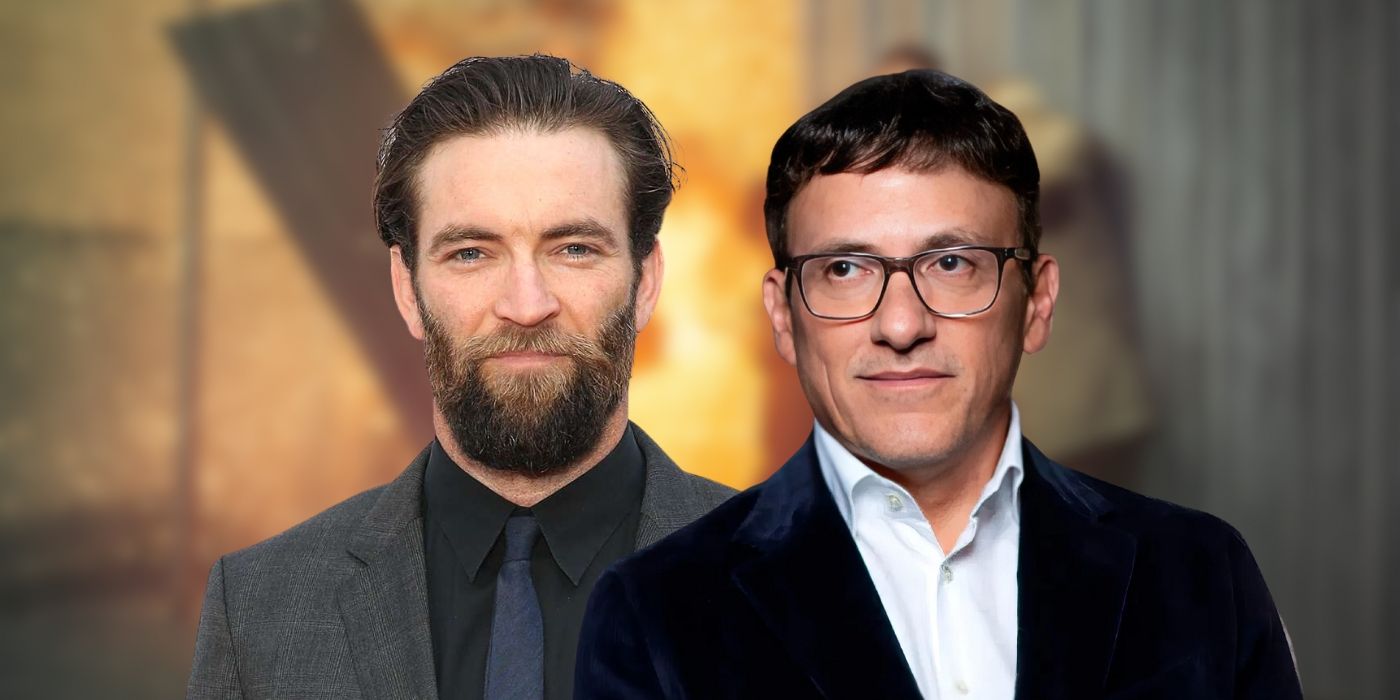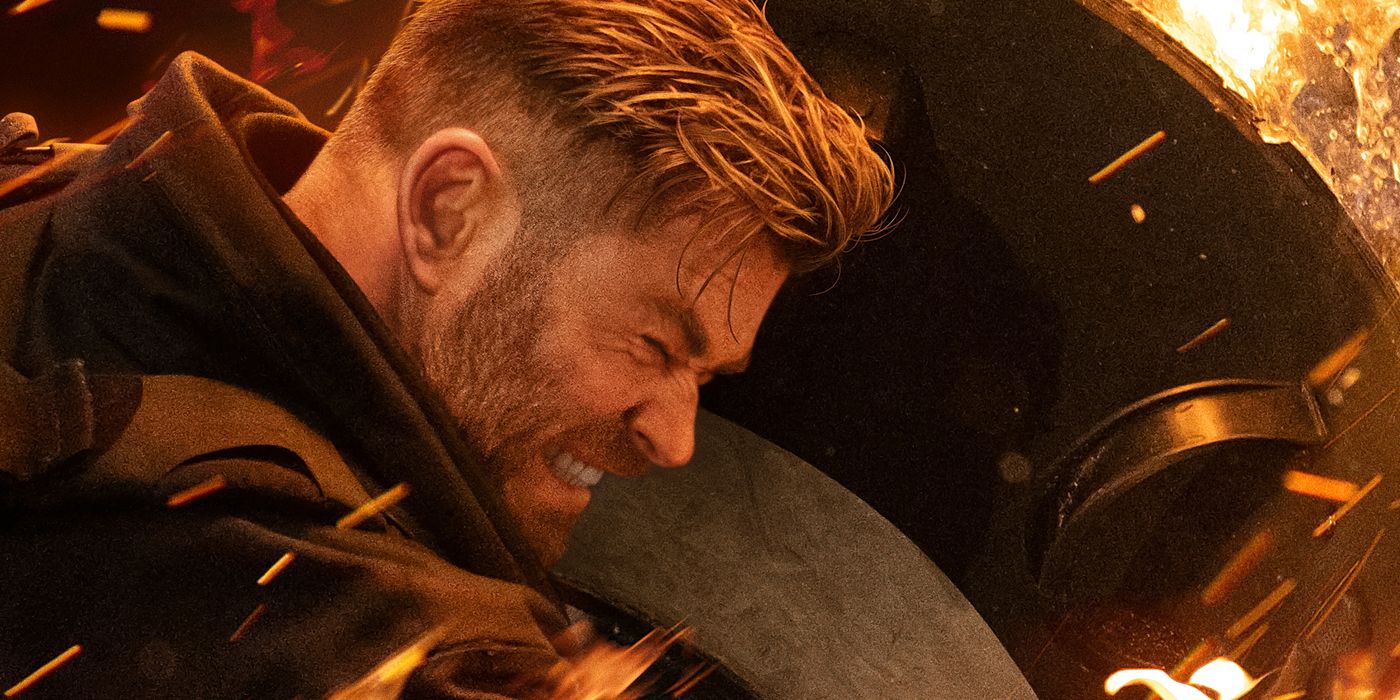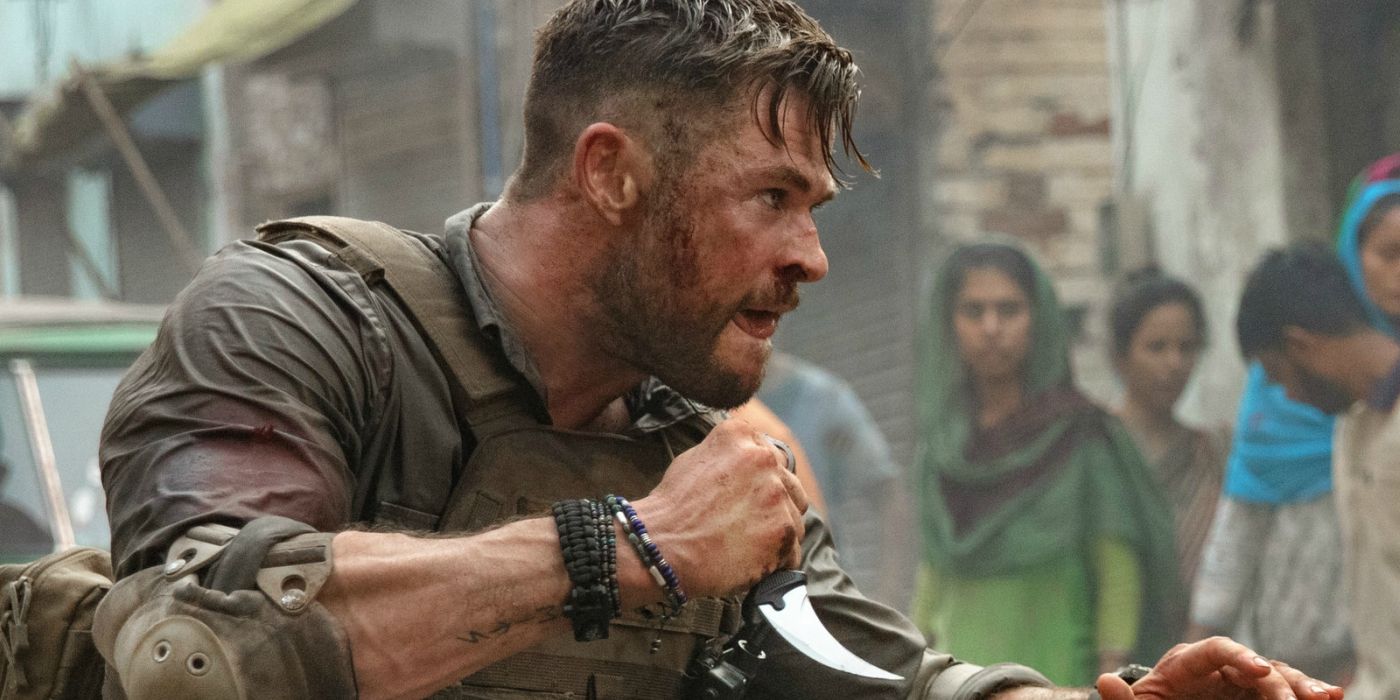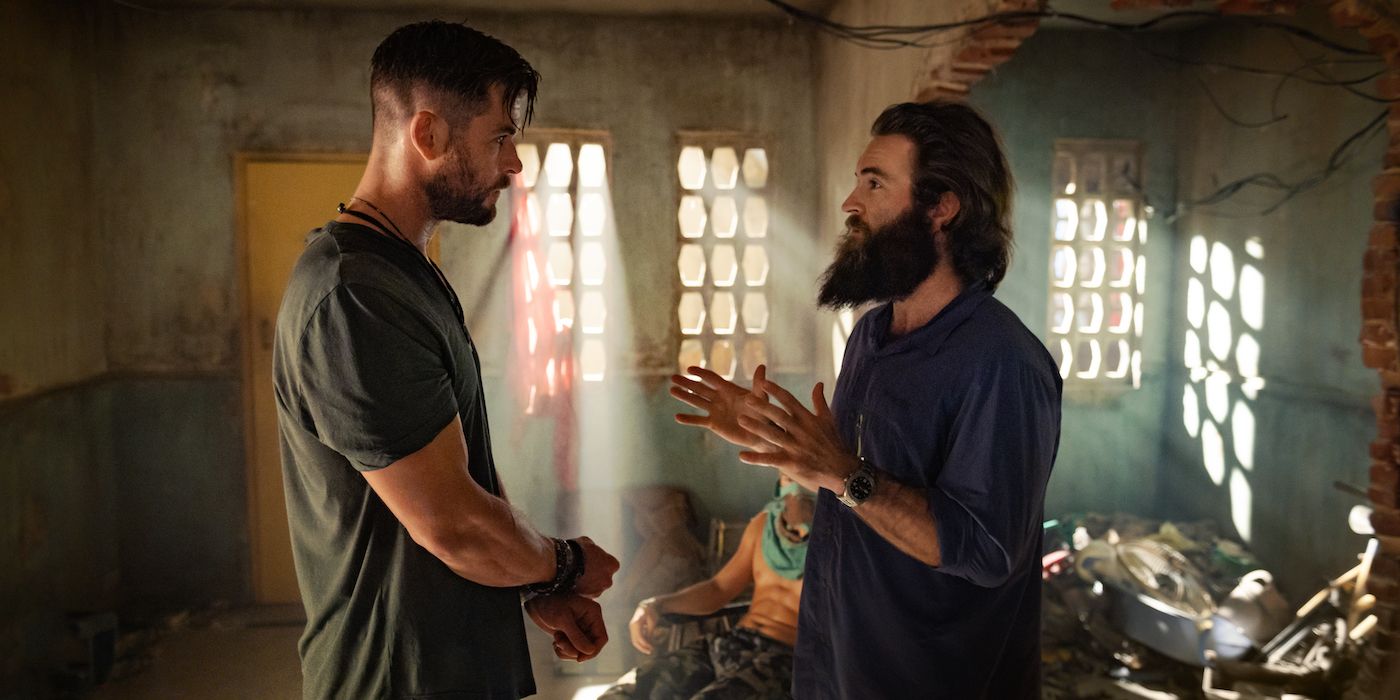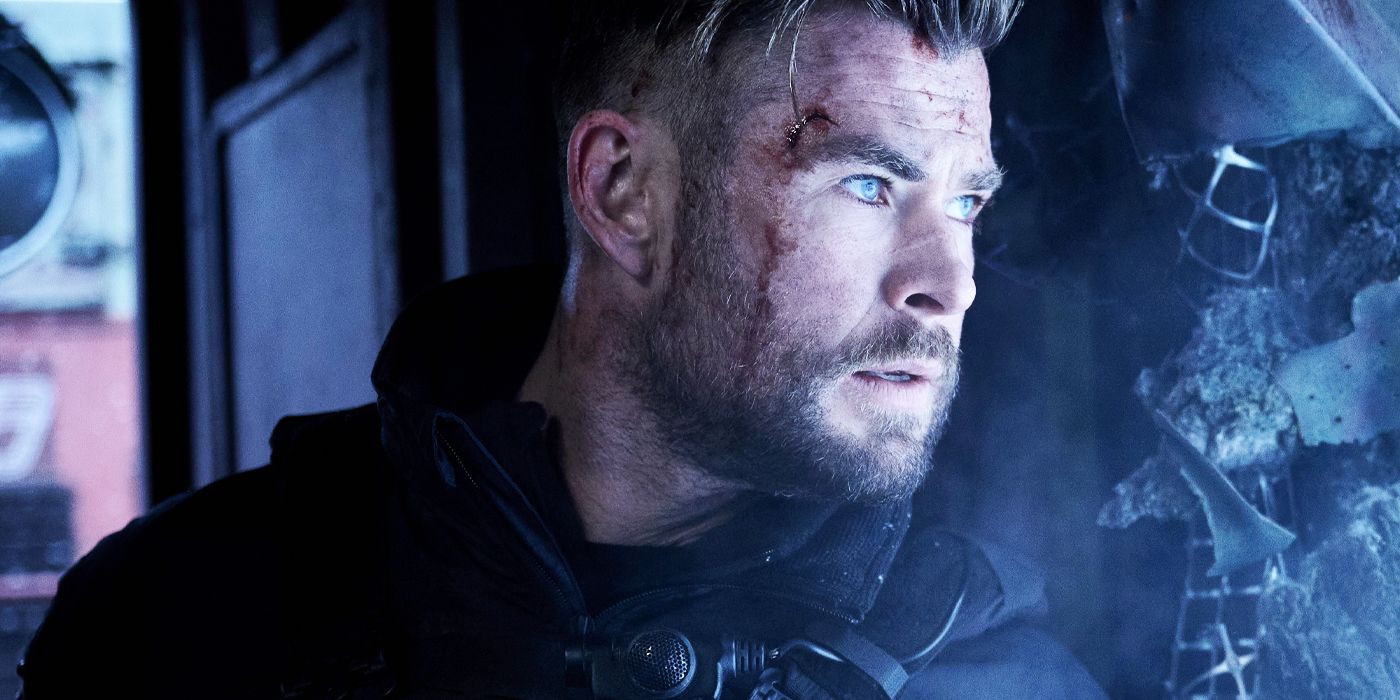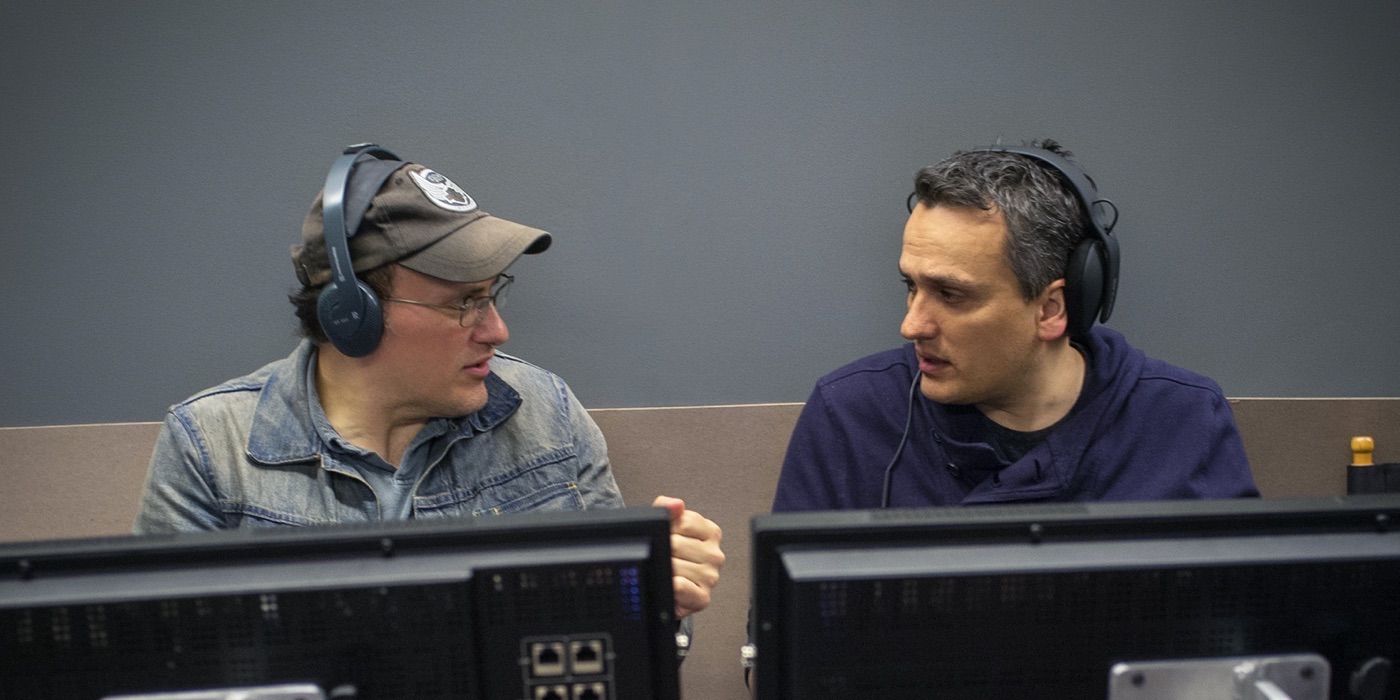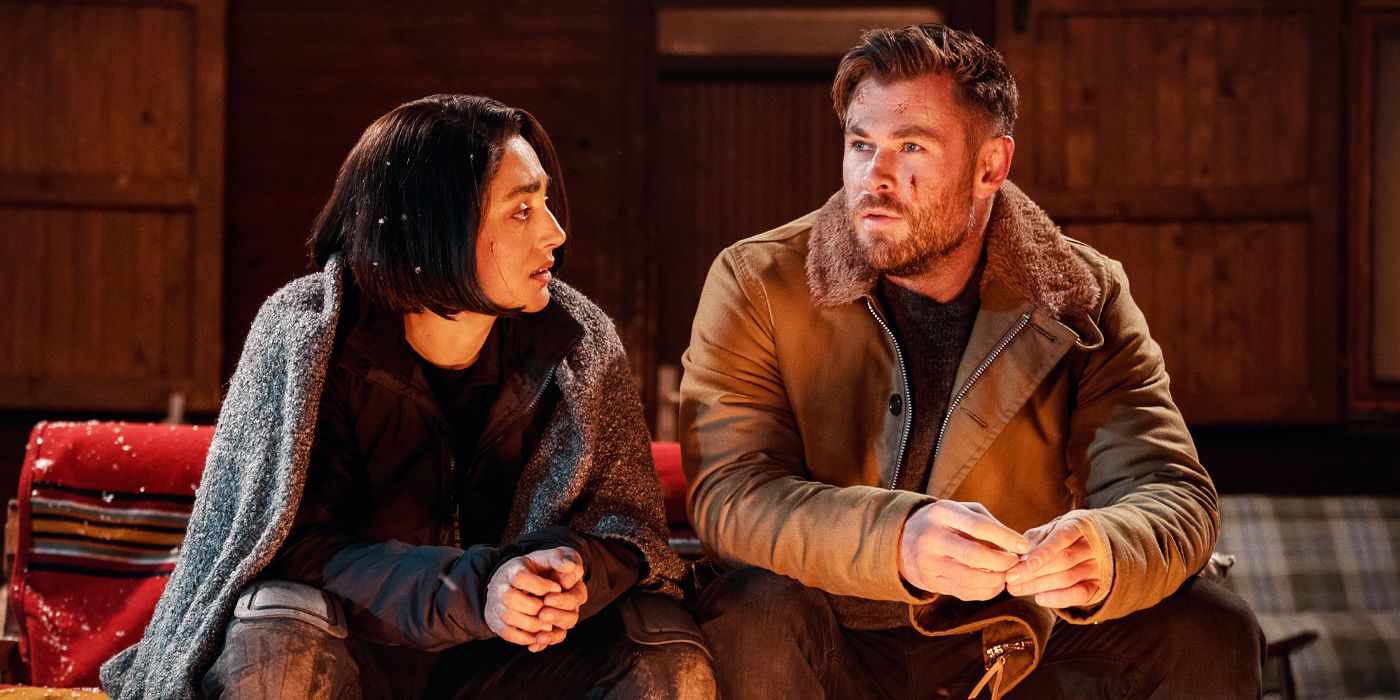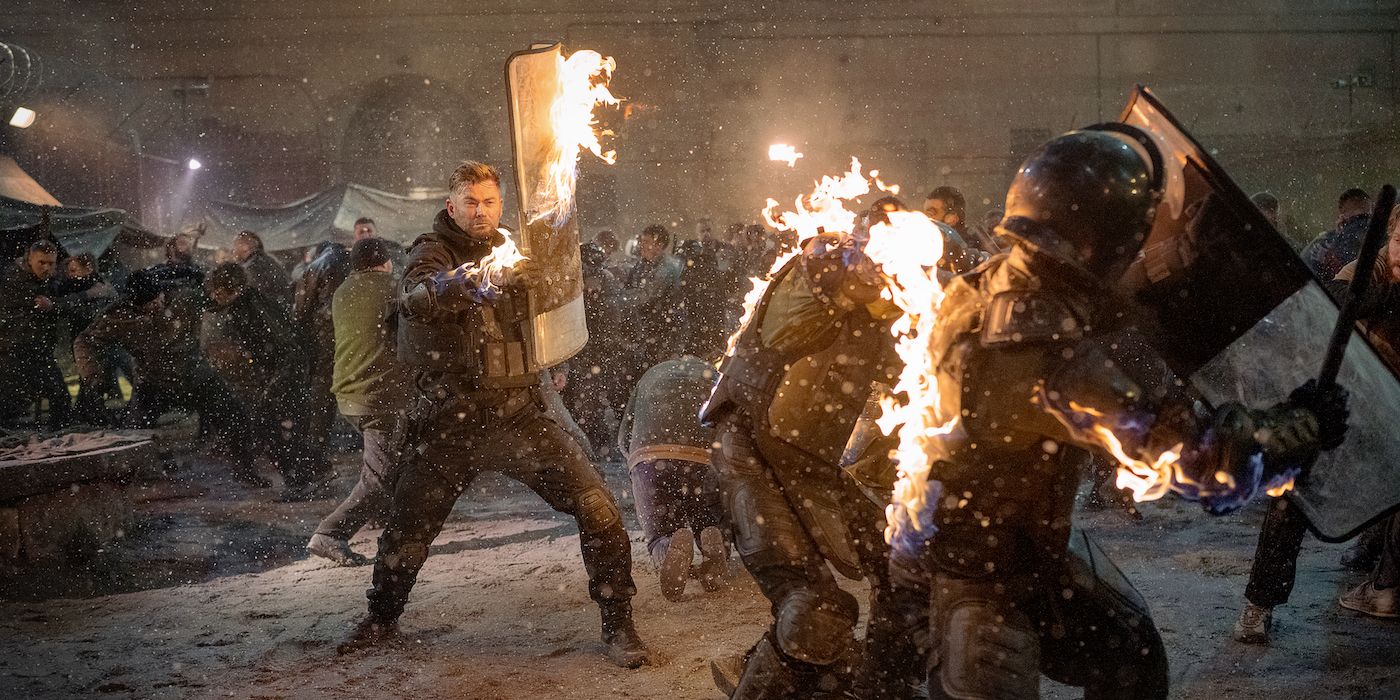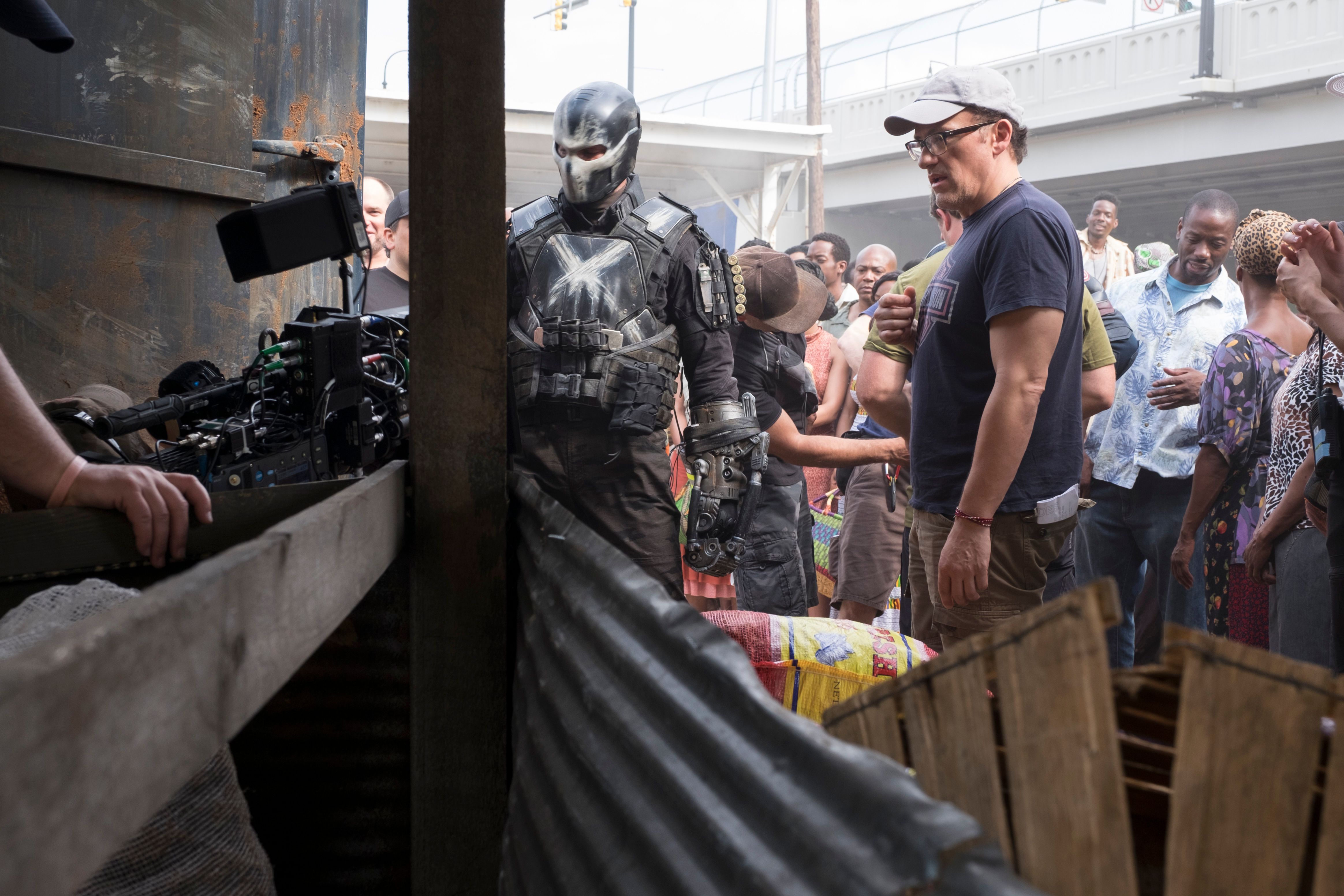Before its Netflix premiere, Collider offered fans a rare opportunity to catch Extraction 2, starring Chris Hemsworth, on the big screen. Following the screening, Editor-in-chief Steve Weintraub sat down with former stunt coordinator and two-time director Sam Hargrave and producer Anthony Russo for an exclusive Q&A. No worries if you had to miss out because we have the full interview here, which you can check out in the video or in the full transcript below.
During the Q&A, Russo and Hargrave discuss the collaboration that went into the project, from the script to the screen, to bring Tyler Rake (Hemsworth) back from the dead. For the sequel—which was almost a prequel—the characters are more fully developed, the action is next level, the kills are bloodier, and the duo discusses it all. Between Hargrave’s extensive background in stunt work and AGBO co-founder Russo’s action-packed resume, Extraction 2 is a spectacle, and we learn all about the groundwork it took to get there.
COLLIDER: Ladies and gentlemen, may I present producer Anthony Russo and director Sam Hargrave. What's funny is, it was a year ago, I think this month, that we did The Gray Man here on this stage, this theater, so I guess this is a yearly thing now.
ANTHONY RUSSO: Yeah, I guess so! I was having strong flashbacks coming in.
SAM HARGRAVE: This is hallowed ground. Honored to be here.
RUSSO: Yeah, this theater is a special place.
So the first Extraction was one of the biggest hits in Netflix history for original movies. For both of you, talk a little bit about what that means to you, especially with it being your first feature.
HARGRAVE: Well, for me, it's a dream come true. As a director and as an artist, to see an audience respond that positively to your work, to two years of your life up on the screen, is amazing. It's the fuel for the fire, it gets you up in the morning. But we had no idea that it was gonna be so well received, so thank you, all fans of the first movie, for responding so positively and, by doing so, creating the impetus for this movie.
RUSSO: We knew it was a special movie after Sam had gone through the process and we had a finished film, but yeah, you never know what the audience reaction is gonna be. And my favorite part of the process is when movies start to become a dialogue with the audience, and I feel like we really experienced that with the first Extraction in terms of the way the movie was received, and the way audiences responded to the movie, I think really helped inform the creative life of the franchise moving forward, which is great.
How quickly was it after that first weekend when it did crazy numbers that Netflix called you and said, “Hey, let's talk about a sequel?” Or was it before the first one came out they were already saying, “I think we're gonna want a sequel to this?”
HARGRAVE: I mean, in my memory, which is fallible, as we were shooting, the script that I signed on for, Tyler's story was finished at the end of it. He didn't survive. But it was early test screenings internally with Netflix and AGBO where we started to say, “We might have something here…” Then once we had an audience test screening early on, we decided, “Let's go back and make sure that we have a way into a sequel should audiences respond as the test audiences did.” And so we had that kind of artistically ambiguous ending, which would allow, should people not respond positively, that we could have a complete story, or if they did, as the audiences did, we could move on to the second one. But it was pretty quick. Once audiences responded and they said there were 99 million views in 30 days or something, they were like, “Well, what's the second one?”
I could never pin Joe [Russo] down on a sequel because, at times, he was talking about it being a prequel or a sequel. Was it always going to be a sequel, or was there actually any sort of chance that it would have been a prequel?
RUSSO: Well, here's the thing, you wanna keep your options open for where you take a story, right? And the thing you know is what you've either written or shot or edited or presented to an audience. That's until you've presented something to an audience. It's all fluid, it remains constantly fluid, and our process is to always be thinking about options and possibilities and different ways we can go to surprise ourselves and, therefore, hopefully surprise audiences. So there are always possibilities in the air about where something can go or what it can be. Including, you know, there's even a way that Tyler Rake died at the end of the first movie, yet there could be another Extraction with another character, right? They're all possibilities. So that was all in the air.
I think the reason why we went in the direction of what Sam was just describing, in terms of figuring out how Tyler could possibly go on, is because people were responding so strongly, not just to the movie, but specifically to Chris Hemsworth's performance as that character. And once we realized how special that character was, that started to sort of guide us.
HARGRAVE: Yeah, and we said, “Bring him back! CPR!” [Laughs]
The action set pieces in this movie and in the first movie are fantastic. Talk a little bit about how it actually gets figured out in terms of, are you coming up with the idea of a prison break, and then we're writing around that? How do these action set pieces and the script get developed together?
HARGRAVE: Well, I know Anthony can probably speak much more closely to Joe's process, but as I understand it, the first inkling I heard of the second movie, once we decided we were moving forward, was Joe said, “I have a really cool idea. I think Tyler Rake should extract somebody, I don't know who it is, but from a prison, all in a oner.” That was the first I heard of it, and I was like, “That's a really cool idea. What else are we gonna do?” And the movie grew from there, and Joe's process, as I understand it, is he's charting the course of the action set pieces so that, as a production, you can start prepping ahead of time while you fill in the details of the story. He's really fast at that, and the stuff happens really quickly, and it's very distinct and strong, that's a strong suit of his, in my opinion. So we had, very quickly, kind of an outline of a really fun journey for the character, locations-wise and kind of set pieces, and we would discuss what would be the most fun thing to do there. But then the life started to come in, and the bones started to be filled out with the meat of the story as we were progressing. That's how I remember it.
RUSSO: I love how you qualify that. That's how I remember it because I'm constantly doing that myself as well. I have no idea if it's accurate or not. I will say this, it was a lot of that idea for the oner moving forward in Extraction 2 certainly goes back to the experience of it in the original Extraction and your sort of vision for that shot and how it could be, what it could be, how to execute it. Any time you try a oner in filmmaking, it's a bit of a scary thing, and it's a commitment because that shot, no matter how long it is, it has to be as compelling and interesting and sort of relentless and sort of textured as any montage of shots you could put together. When you play out the oner, you're like, “If I wanna put scissors here and cut this up for any reason, then it shouldn't be a oner.” So, there's a really high threshold for a shot like that to work, and Sam was so focused on that in the original film, that shot, and he executed it so well, and it surprised all of us that it worked so well! [Laughs] Ultimately, everybody was a little anxious about it. So I think that was certainly the inspiration—what you were able to do with that creatively—was certainly the inspiration for expanding upon that idea.
I could be wrong about this, but with Extraction 2, originally, I read that it was going to be filmed in Australia, and then you moved it. So was the film different when it was going to be in Australia, or what happened?
HARGRAVE: That is correct. We originally decided to shoot in Australia for many reasons, one of which was at the time, it was COVID-free. This is 2021, and there was not a single case on the island, so we were like, “Great choice, no masks!” Just so happens that during our quarantine, the outbreak started. And it wasn't us, talk amongst yourselves, we didn't bring COVID to Australia, somebody else did. [Laughs] That's how I remember it.
RUSSO: You're not gonna say who?
HARGRAVE: No, I'm not naming names. However it happened, COVID kind of spread very quickly. We tried to persevere as long as we could. We actually got to within seven or eight weeks before it started to film when we had to pull the plug and leave. So we had spent like 16 weeks prepping in Australia. We had stages full of built sets, we had locations set, we had cast and roles that we had to recast. I remember being at the prison because we had the oner ready to go over there in an Australian prison, and I was there rehearsing with 50 stunt performers, and I got the call on a Friday, and Patrick Newall, our line producer, said, “We're leaving Australia,” and I said, “Should I tell them or do you want to?” And he's like, “No, you're already there, you go ahead and tell them.” And so I did, and it was really tough because you gotta say, “Hey, the good news is… Well, let me start with the bad news, we're leaving Australia, but you're all welcome to come with us,” because we wanted to honor our commitment to the team.
Long story short, some of them came, and we had to go to Prague, and I think it was kind of a fortuitous decision because aesthetically for the film, I think it ended up being a happy accident, if you will. Because the visuals became much more authentically cold, and the blue aesthetic that you saw up here helped differentiate the movie from the first one. So I think it worked out best for the film. It sucked for the crew and the people in Australia, it was really tough and frustrating, but for the movie, for the final product, I think it actually worked out pretty good.
I think a lot of people are going to think in this day and age, “So much of this is CGI, not much of this was practical,” whatever it may be. So for everyone here and for everyone who is watching the Q&A, can you talk about the fact that this was done practically? What was practical, what was CGI? There were risks involved, especially in the train sequence.
HARGRAVE: Yes, that was really risky business… I think the difficulty nowadays is there are so many great action movies—I mean, I'm sitting next to one of the great action directors of our era, actually—there are so many great action movies that the real question is, how do you differentiate yourself in that pantheon that has come before of great films? And I think all I can do as a filmmaker is give my specific point of view, and oftentimes these long extended takes in real locations with real stunts and practical effects, that's my choice of how I want people to experience these sequences. It doesn't make them better than any other sequence, it's just different, it's my point of view. And if you gave the sequence to the Russo Brothers, it'd be freaking amazing but different. Same thing if you gave it to [Christopher] McQuarrie, it'd be different but amazing.
Most of what you're seeing in camera is practical. There were times when, for example, the interiors of the train, for the logistics sake, so that we could carry a set, like a rain cover set, we kept those and shot those on a stage with a blue screen out of the sides of the train. But anything on the exterior of the train, including landing a helicopter on a moving train, was 100% practical, which by its very nature and description is very dangerous.
RUSSO: I just want to add that's something that Joe and I have never done as directors, and I don't think we could do that.
HARGRAVE: Well, thank you, I appreciate that. And you know, I think the hardest part was convincing everybody that that was the way that I wanted to do it because you could do it different ways; you could do it 10 different ways. It could be practical. You could be outside and have a big crane, swing the helicopter over and drop it down on the train, and have a big blue screen, and it's been done that way. But, in my estimation, you wouldn't provide the audience with the same adrenaline-filled experience by faking it, and there are certain times when I think the risk is worth the reward.
In that instance, we rehearsed for three or four weeks, just that one part, so that all the variables and all the dangerous elements were identified. And then, we tried to limit the amount of risk because we all want to go home at the end of the day to our friends and loved ones. So we're taking risks, but they're calculated risks, and it's all for you, for the audience, because I think that adrenaline that exists in my body as I'm holding the camera, that fear is translated through to you, it comes through the screen, and you can feel it and your heart beats faster, probably because mine was beating faster. We should probably do that, actually; hook me up to a heart rate monitor and see what my heart rate is doing that, and what yours is experiencing it. I think that'd be very interesting.
RUSSO: I want to just add a little of my perspective on what Sam is talking about. Many of you may already know this, but you have to understand Sam's background and his history as a stunt performer, as a stunt coordinator, as an action second unit director, as a camera operator, et cetera, his entire road to directing. There are few people on the planet that are as experienced with inventive, ambitious action, staging action, as Sam is. What he's done throughout his career has been very unique and remarkable, and he's able to do things that other people are not capable of on that level because of his passion and his dedication and his training and his creativity. He's traveled a very specific road through his career to this moment in time to what he's been able to pull off with Extraction 2.
HARGRAVE: So what he's saying is, don't try this at home–trained professionals.
RUSSO: [Laughs] I would say you don't just pull it out of your ass.
I think that you've left out a little asterisk to the scene, which is, on that train sequence, you were the one holding the camera when the helicopter landed, and what happened to you?
HARGRAVE: Well, during the first take, actually, when the helicopter came in, I knew that there is some wind generated by the downdraft of a helicopter. It stands to reason for them to fly, there has to be force and physics and yada, yada, yada, but I didn't realize how much force. And so when I ran up alongside this helicopter, I walked into a hurricane, and it blew me sideways and almost off the side of the train. Fortunately, again, one of the things that we're taking into consideration is that might happen, so we had a safety line running along the base of the train hooked to a harness that I was on, which saved my life. I also saved the camera because that's one for behind-the-scenes, you want.
RUSSO: Was the camera cabled, or was it just your iron grip?
HARGRAVE: It was just my sheer iron grip? I think it was fear. It took five minutes to get it released from my hand. That was take one, and I was like, “Alright, I know what to expect for take two!” And you can see, if you watch it again, and what we used, I believe, was take three, but you can see, as the camera goes underneath the helicopter, that it starts to get a little more wobbly. That's not just my fear coming through, it's the downforce of that wind that's just blowing. I'm trying my best to operate and keep them in frame, but it’s a wild experience. I mean, no, I don't recommend it.
Did you come up with any action sequences or ideas for an action sequence that, for some reason, didn't work out on this movie, and you have it in the back pocket for the hopeful Extraction 3?
HARGRAVE: Two trains. [Laughs] No, I think [Russo] probably remembers, my big pitch was there should be two trains; it's Extraction 2. [Audience laughs] Yeah, that was the response I got. It's like, “Just stick with one, pal. Just do one train. You're already cutting it close.”
I'm obsessed with the editing room because, as you both know, that's where a film comes together. So how did this film change in the editing room after friends and family screenings in ways you didn't expect?
HARGRAVE: Well, actually, this movie changed from the scripted form, the version that you guys saw has changed so many times. But I think the biggest change was the structure. The movie originally opened with the oner, or at least the script did, and it read amazing because when you read it in Joe's writing, it's tense and it's action-packed, and you just can't put it down, and next thing you know, you're finished and wanting more, but that doesn't always translate on screen. What we found was 21 minutes of action is exciting, but if you don't know who these characters are and what they're fighting over or for, you're just kind of like, “Okay, let's get to the good stuff.” Then when you switch it, and you put 25 minutes of story-building and an emotional connection to these characters, once the action starts now, you can't take your eyes off the screen because you're emotionally invested in the journey, and you care what happens to Tyler, you care what happens to this family because you know what the stakes are.
So that was something that I found very interesting that we just changed that in the editing room, and it worked a lot better. You guys can attest to—well, maybe not, but hopefully—being a little more emotionally involved by the time that oner rolls around. I think it's interesting because it’s one of those things that I'm sure, at some point, will rock up on YouTube and be played just as an action sequence, and I'm sure it'll be fun to watch, but it won't mean nearly as much as it does to you who've seen the whole thing because then there are stakes. I think that's what makes action sequences so potentially effective. What I've learned from working with the Russo Brothers is action is all about character and all about emotional stakes.
RUSSO: Yeah, absolutely. It's interesting, along the road that we've traveled in order to learn this, in terms of in a tactile way. Because, you know, even if something seems intuitive, I think when you're an artist, and you're creating something, you want to test ideas. You don't want to just accept a premise. You wanna figure out why; why does it need to be like this? And you really wanna feel it. So I think over the years, we've played with this idea of action without being connected to emotion or those kinds of things, and it's like you can have the coolest shots, and you can montage them in the best way, and you can have a remarkable action, but if you don't have a clear emotional connection to what's happening within the action, your mind starts to wander after about 30 seconds. That's how quickly it happens. So yeah, in order to make action really fun for an audience, you have to do exactly what Sam is saying. Just figure out how you imbue every moment of it with character and story and stakes and emotional investment.
I'm curious what it's like for you, Anthony, as a producer of the movie; how involved are you in watching every edit and giving notes? Like the behind-the-scenes of the AGBO of it all.
RUSSO: AGBO was conceived as an artist collective, and that's really how we run it. You know, we have amazing partners there, like Chris Markus and Stephen McFeely and many other people. So part of the virtue of AGBO’s process is that we have a lot of people putting eyes on all the material and sort of giving feedback in terms of what something can be, where it can go, but those ideas are offered in a way that is useful to the process. That’s, I think, how we're different from some other places where there may be less sensitivity to the process and what something wants to be on a creative level. So that's kind of how AGBO functions.
Now, every project has a different level of involvement by the different people at AGBO. Joe is much more hands-on on this project, having written it, so he's much more tuned in to the sort of detailed evolution of the project. I'm a little more sort of one step back from that. But yeah, it's an incredibly important part of the process, the screening part of the process, getting the material on fresh eyes, people who might not be as invested in certain ideas and as locked into how something was done or why it was done that way, just more open to like, “Well, how is it translating on screen?”
HARGRAVE: And I think one of the most important director/producer relationships, and it might sound counterproductive, but is one of challenging ideas. Because I might have an idea as a director and, you know, the producer who's got some experience challenges that, not saying they disagree, they're just challenging and saying, “Why do you think that should be in my movie?” And if you can't defend it, if you can't put up a logical reasoning why you feel passionate about this being in there, then it's a great backstop for creative ideas. Because, you know, two trains! [Laughs] And they say, “Why two trains?” And if I can't defend it in a logical way that makes sense for the story, then it falls by the wayside. I think that's important because if you just get anything you want, anything that comes into your head, you get some, you know, pretty messy art. So you need to have collaborators who are willing and brave enough to challenge you and say, “Hey, are you sure this is the best idea? Tell me why.”
So I think that's a great part about AGBO is it is kind of an artist collective in that they're the backstop for the creative ideas that flow out. And the “the best idea wins” adage that I learned from these guys, I think that's how they operate, and it really helps the product.
Sam, I'm curious, before your picture locked, what was the last thing you cut out of the movie and why?
HARGRAVE: The second train? [Laughs] No, that would have been a lot of money to leave on the floor.
RUSSO: If the second train had made it that far, I think it would have gone the distance, right?
HARGRAVE: Alright, we’ve worn that joke out. I don't remember, but I do believe I know the last thing we got in was the scene with Nik (Golshifteh Farahani) walking in with and talking with Ketevan (Tinatin Dalakishvili) about second chances. That scene with the two women in the bedroom with the kid lying there. For a long while, it wasn't in there because it wasn't directly related to Tyler Rake's story and his journey, but then I fought for that to remain because, indirectly, it is talking about Tyler and his journey because “everyone deserves a second chance” is kind of the information Tyler needs. Because of the guilt he feels and the shame he feels about his decisions from the past, he's like, “Why am I here? I don't deserve a second chance.” And so it's kind of echoing what she said to him in the opening—she being Gol, the character of Nik, said, “You just need to find out why.” And I think in her mind, everyone deserves a second chance, and then that ties into Rake going after the kid because he might have messed up, but maybe he deserves a second chance. So that scene kind of came back because it supported the armature of second chances and redemption. But then that was a very late reentry to the cut.
One of the things I really appreciate about this movie and what you do is there's some pretty brutal violence.
[Audience applauds]
HARGRAVE: Savage! I love it.
I didn't see this audience, but last night, when I saw it with a huge crowd, people were reacting, freaking out when—I don't want to do spoilers, but when certain people get killed. There are certain things with weight or two… So how much of that is in the script with Joe saying he gets killed by a weight and a weight machine? And how much is that you guys in the moment saying, “How can we make this just bloody?”
HARGRAVE: Well, we're all seeking that fan appreciation of crazy kills because, again, so many amazing action movies, so many “great deaths” that get recorded, it's hard to stand out and be remembered. So a lot of times, I think what Joe does so well is he'll write a wild action sequence, and there are some pretty great kills in there. Then I, as the director, and then when I hire the stunt team, the collective “we” try to take what's there, and it's already good, “How do we make it better?” That's always the goal. You get a really good script; how do you make it even really gooder? [Laughs]
So in an instant like that, when we've got this gym at our disposal, literally a playground, we say, “What are the myriad ways we can end someone's life in this space?” And then it's, you know, getting a bunch of sick, twisted minds—[to audience] yeah, that’s you—together, which is also the stunt team, and devising lots of different ways. It becomes a buffet. In my job, a buffet of violence…it's a buffet because, with the adage of the best idea wins, I'm not always the best one to bring that idea to the table. It's not always Joe, it's not always Anthony. We have good ideas, but the reason filmmaking is so fun is it's collaborative, and so you surround yourself with amazing artists and then be open to their great ideas. Then as a director, my job is to curate those ideas, to pick from the buffet, “What delicious treat can we serve up for the audience? And how does it fit into the dish that I'm trying to prepare as a master chef?” Beat that one to death—no more food analogies.
But specifically the weights, there were probably dozens of ideas just within that space of ways that the stunt team came up with to end people's existence. So then I had to go, “Eh, seen that one,” or like, “That's too violent.” And then sometimes that's the hardest part, is picking the best ideas from a list of great ones. That's really tough. I think we landed on two or three exciting versions of that.
RUSSO: I just wanna mention one thing along the lines of what Sam has been talking about. Certainly, there's a creative process that involves not having to explain to other people what you're doing, not having to make others understand it, just doing work that ends up becoming something that people can experience. But, if you're gonna ask other creative people to collaborate with you in order to create it, then in that situation, you do have to communicate your ideas because that's the essence of collaboration, is your ability to communicate with, whether it be an actor or part of your stunt team, or a producer, or maybe even a financier, whoever it might be, who's ever coming to the table, to help you collectively make this movie. You have to be able to communicate with one another about what you're all doing together.
HARGRAVE: And to piggyback on that, just a fun aside, which you guys might eat up, my job is to communicate a feeling because I might not be the best one to say how exactly we're gonna do it. For example, in the fight in the courtyard, in the prison break, I knew a feeling I wanted to evoke, and rather than say, “It has to be this karate chop, and this shot to the leg,” whatever that action is specifically, I pulled up a video on YouTube—great resource—and it was of a lion fighting off a pack of hyenas, and I played that for the stunt team. I said, “This is the feeling I'm going for.” I was like, “Tyler Rake is the lion, in case you were confused, and the hyenas are all the prisoners around him.” And it ounds funny, but when you look at it, and you look into the eyes of that lion, there's a desperation there, there's a commitment to survival, and then you watch the kind of attack methodology of the hyenas, and it's very savvy. They're coming at him from all angles, and they attack multiple hyenas at a time. They go for the weak points. I said, “I don't really care how it is we arrive there, what moves you decide to do, but I want that feeling.” And so then they go off and they create something. They come back, and then I have to go, “Alright, well, that move doesn't match with what I saw there,” and now it becomes a collaboration. But ultimately, communicating that feeling to the people who are gonna help you create the moves is my job.
This is a directing question for both of you; what shot or sequence—maybe it's in this film or the first Extraction or when you did stunt directing previously—was like the back-breaker? The one that was like, “Holy f, how are we gonna do this?”
RUSSO: I could talk about so many. They're all back-breakers.
HARGRAVE: Making action movies will break your back.
RUSSO: Yeah, which is where my brain is going, to the literal version of this answer, which is, I remember early on in our collaboration with Sam on Captain America: The Winter Soldier. There’s this moment where my brain just went to this moment—you can describe it in more detail, but Cap was falling from a far height, and he sort of lands on this dumpster, and boom, hits the ground. And Sam was performing this, and it was such an intimidating stunt that I really…I felt like I couldn't even watch it happen. I'm not kidding you. [Laughs] I was so nervous about it. But Sam did, in fact, get hurt there. You want to talk a little bit about that?
HARGRAVE: Yeah, if we're talking about the same one, it might have been Civil War, the one we came when he came out of the roof and hit the truck?
RUSSO: Yeah, sorry.
HARGRAVE: Well, we did a lot of cool stuff together on both movies, but my memory is burned into mine. I was there. I was super proud of this, and actually, we could do a two-for-one here because that actually might make my list of back-breakers of most difficult but also kind of most proud of. I remember sitting in the room and talking about it, it was in the script, and it was an explosion that goes off, and Captain America flies out of a window and lands on the pavement, and I was like, “Yeah, that's cool. What if…?” And I spoke up in the room. We were there just kind of brainstorming with the writers and with Joe and Anthony, and I said, “What if, as he goes out of that window, he clips a balcony, he flips upside down, and he hits another balcony and then falls onto a truck, and then he falls down to the ground?” And they were like, “Okay, if you can do that…” I was like, “Not quite sure, let me get back to you, but if I can, can we do it?” And they said yes.
So from conception to execution, I had to go work with the art department and do all the measurements and build the angle– you know, we had to build this on the side of a…it didn't exist where we wanted to shoot, so we used the existing balcony, built the second balcony and parked the truck. We built a padded station for the ground to fall on, and then it came to the doing of it. And I shared that stunt, actually, with another stunt performer named Jackson Spidell, who is an amazing stunt double. He did the talent portion, which is he's on a wire rig, and he has to do the flip over the railing, which takes a lot of skill. I did the gravity portion. Once that happened, it was like, “Alright, Sam, you go in there,” and so I hung on to the side of a Condor, this lift, and then it's, “3…2…1, let go.” So then gravity took over, and I fell, hit the balcony, and then fell 10 feet to the truck, 10 feet to the ground, and yeah, it took me a while to get back up after that one. And I didn't literally break my back, not that I remember. It just looked that way. But I did suffer a pretty severe concussion. I was hobbling around for a few days with a lot of bumps and bruises.
But I remember being very proud of that, not only because I survived, but because Joe and Anthony allowed me, in the room, to kind of speak up and get my creative vision on screen. Then I got to go out and help them build it, and then I got to do it. So from perception to completion, to be part of that was really special.
RUSSO: I mean, I have to say that I think the most amazing thing about that story is that Sam was able to go on and make a movie like Extraction 2 afterwards.
HARGRAVE: I could still walk away and remember my name.
The director here has a cameo in Extraction 2. Did anyone pick it out?
[Audience replies]
HARGRAVE: Ditch digger burying the bodies; you are correct. I thought I did a better job of disguising myself.
RUSSO: And why did you choose that role?
HARGRAVE: It was a bit of a fortuitous…I felt like I was digging my own grave with this career choice. I’m like, “What am I doing this up? Doesn't get any worse than this!” No, truthfully, the reason was in the first film, I had a cameo and doing that, it was only three days of shooting, but those were the hardest three days of my life. It gave me a renewed, profound respect for actor-directors like Ben Affleck. Even Joe does that. He gets in the movies and has parts where you're speaking. Because there's so much pressure because you go, “Do I go again? As a director, I need another take, but as an actor, I don't want to be unfair to the other actor in the scene. He did it in two, and I need a seventh take.” [Laughs] So it's really tough. It's a lot of pressure, and it takes, for me, twice as long because you’ve got to perform it and then go back and watch it on playback, and you just feel like, “Oh, I'm wasting time. What am I doing? I should have put someone else in this spot.” So I figured, what's the worst could happen? I'm digging a ditch, and luckily I didn't hold production up. We did not have to go again for me, thank god.
Did you really try to keep yourself anonymous? You thought you weren't gonna get picked out?
HARGRAVE: Well, I mean, I put a wig on, and I colored my beard, and…kinda. [Laughs]
Extraction 2 is now streaming on Netflix. Check out Collider's interview with Hargrave and Chris Hemsworth below.

